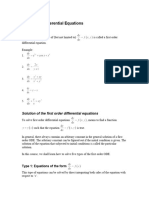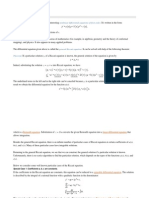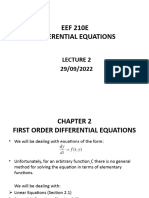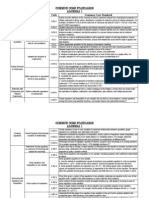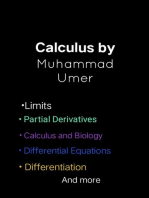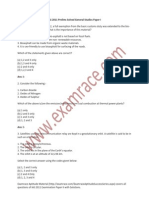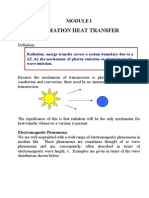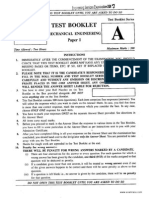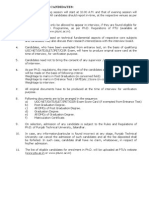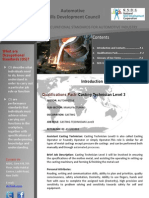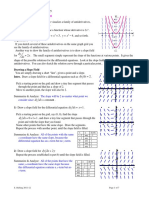Intigeration
Uploaded by
BalvinderIntigeration
Uploaded by
BalvinderThe Indefinite Integral and Basic Formulas of Integration. Table of Integrals.
Definition of the Antiderivative and Indefinite Integral
The function F(x) is called an antiderivative of f(x), if
The family of all antiderivatives of a function f(x) is called the indefinite integral of the function f(x) and is denoted by
Thus, if F is a particular antiderivative, we may write
where C is an arbitrary constant.
Properties of the Indefinite Integral
In formulas given below f and g are functions of the variable x, F is an antiderivative of f, and a, k, C are constants.
Table of Integrals
It's supposed below that a, p (p 1), C are real constants, b is the base of the exponential function (b 1, b > 0).
Example 1
Calculate
Solution.
Example 2
Calculate the integral
Solution.
Transforming the integrand and using the formula for integral of the power function, we have
Example 3
Calculate
Solution.
We use the table integral
. Then
Example 4
Find the integral
Solution.
Using the table integral
, we obtain
Example 5
Calculate the integral
Solution.
Since
, the integral is
Example 6
Find the integral
Solution.
without using a substitution.
Using the double angle formula sin 2x = 2 sin x cos x and the identity sin2x + cos2x = 1, we can write:
Change of Variable Let F(x) be an indefinite integral or antiderivative of f(x). Then
where x = g (u) is a substitution. Accordingly, the inverse function u = g 1(x) describes the dependence of the new variable on the old variable.
It's important to remember that the differential dx also needs to be substituted. It must be replaced with the differential ofthe new variab For definite integrals, it is also necessary to change the limits of integration. See about this on the page "The Definite Integral and Fundamental Theorem of Calculus". Example 1
Calculate the integral Solution. Let . Then
. Hence, the integral is
Example 2
Find the integral Solution.
We make the substitution . Then The integral is easy to calculate with the new variable:
or
Example 3 Calculate the integral .
Solution. Rewrite the integral in the following way:
Noting 2e = a (This is not a change of variable, since x still remains the independent variable), we get the table integral:
Example 4 Calculate the integral Solution. We can write the integral as .
Changing the variable
we get the answer
Example 5
Find the integral Solution. We make the following substitution:
Hence,
Integration by Parts Let u(x) and v(x) be differentiable functions. By the product rule, Integrating both sides of the expression, we obtain
or, rearranging terms,
Integration by using this formula is called integration by parts. Example 1 Compute Solution. We use integration by parts: . Let . hen .
Hence, the integral is
Example 2 Integrate Solution. We are to integrate by parts: u = ln x, dv = dx. The only choices we have for u and dv are . Then .
Example 3 Calculate the integral Solution. .
Use integration by parts:
. Then
, and the integral becomes
To calculate the new integral, we substitute
. In this case,
, so that the integral in the right sid
Then the result is
Example 4 Find the integral Solution. We use integration by parts: integral can be written in the form: . Let . Then .
,so th
Apply integration by parts one more time. Now let integral we started with is
. Hence,
, so that th
Solving this equation for this integral, we obtain
Example 5
Find a reduction formula for Solution. We apply integration by parts:
. Let
. Then
Hence,
Solve the equation for
. As a result, we obtain
Integration of Rational Functions
A rational function 1.
, where P(x) and Q(x) are both polynomials, can be integrated in four steps:
Reduce the fraction if it is improper (i.e. degree of P(x) is greater than degree of Q(x));
2.
Factor Q(x) into linear and/or quadratic (irreducible) factors;
3.
Decompose the fraction into a sum of partial fractions;
4.
Calculate integrals of each partial fraction.
Consider the specified steps in more details. Step 1. Reducing an improper fraction If the fraction is improper (i.e. degree of P(x) is greater than degree of Q(x)), divide the numerator P(x) by the denominatorQ(x) to obta
where is a proper fraction. Step 2. Factoring Q(x) into linear and/or quadratic factors Write the denominator Q(x) as
where quadratic functions are irreducible, i.e. do not have real roots. Step 3. Decomposing the rational fraction into a sum of partial fractions. Write the function as follows:
The total number of undetermined coefficients Ai , Bi , Ki , Li , Mi , Ni , ... must be equal to the degree of the denominatorQ(x).
Then equate the coefficients of equal powers of x by multiplying both sides of the latter expression by Q(x) and write the system of line equations in Ai , Bi , Ki , Li , Mi , Ni , .... The resulting system must always have a unique solution. Step 4. Integrating partial fractions. Use the following 6 formulas to evaluate integrals of partial fractions with linear and quadratic denominators:
1.
2. For fractions with quadratic denominators, first complete the square:
where
Then use the formulas:
3.
4.
5.
The integral
can be calculated in k steps using the reduction formula:
6. Example 1
Evaluate the integral
Solution. Decompose the integrand into partial functions:
Equate coefficients:
Hence,
Then
The integral is equal to
Example 2
Evaluate
Solution. First we divide the numerator by the denominator, obtaining
Then
Example 3
Evaluate the integral Solution. We can write:
Example 4
Evaluate the integral Solution. Decompose the integrand into partial functions:
Equate coefficients:
Hence,
Then
The integral is equal to
Example 5
Evaluate
Solution. Decompose the integrand into the sum of two fractions:
Equate coefficients:
Hence
The integrand can be written as
The initial integral becomes
Example 6
Find the integral
Solution. We can factor the denominator in the integrand:
Decompose the integrand into partial functions:
Equate coefficients:
Hence,
Then
Now we can calculate the initial integral:
Example 7
Calculate the integral Solution.
Rewrite the denominator in the integrand as follows:
The factors in the denominator are irreducible quadratic factors since they have no real roots. Then
Equate coefficients:
This yields
Hence,
Integrating term by term, we obtain the answer:
We can simplify this answer. Let
Then
Hence,
. The complete answer is
Example 8
Evaluate the integral
Solution. We can factor the denominator in the integrand:
Decompose the integrand into partial functions:
Equate coefficients:
Hence,
Thus, the integrand becomes
So, the complete answer is
Example 9
Calculate the integral Solution.
Decompose the integrand into partial functions, taking into account that the denominator has a third degree root:
Equate coefficients:
We get the following system of equations:
Hence,
The initial integral is equal to
Example 10
Find the integral Solution. Since
is reducible, we complete the square in the denominator:
Now, we can compute the integral using the reduction formula
Then
Integration of Irrational Functions To integrate an irrational function containing a term we make the substitution .
To integrate an irrational function involving more than one rational power of x, make a substitution of the form to be the least common multiple of the denominators of all the fractional powers that appear in the function.
, wheren is ch
An expression rational in x and
is integrated by the substitution
. and
See Trigonometric and Hyperbolic Substitutions about integration of irrational functions involving Example 1
Find the integral Solution. We make the substitution:
Then
Example 2
Calculate the integral
Solution. We make the following substitution: Then the integral (we denote it by I ) becomes
Divide the fraction:
As a result, we have
Example 3
Evaluate the integral Solution. We can write the integral as
Since the least common multiple (LCM) of the denominators of the fractional powers is equal to n = LCM(1,3) = 3, we make the substi
Thus
Make the new substitution:
The final answer is
Example 4
Evaluate the integral Solution. We can write the integral as
Make the substitution:
The integral becomes
Since the degree of the numerator is greater than the degree of the denominator, we divide the numerator by the denominator:
The integral is equal to
Example 5
Find the integral Solution. We can write the integral as
As can be seen, the least common multiple (LCM) of the denominators of the fractional powers is equal ton = LCM(3,4) = 12, we make substitution:
This yields
The degree of the numerator is greater than the degree of the denominator, therefore, we divide the fraction:
After simple transformations we obtain the final answer:
Example 6
Evaluate Solution. Make the substitution:
This yields
Example 7
Calculate the integral Solution. We make the substitution
As a result, we have
Integration of Rational Expressions of Trigonometric Functions Any rational expression of trigonometric functions can be always reduced to integrating a rational function by makingthe
universal trigonometric substitution x = 2arctan t (or
).
The following trigonometric formulas are used to transform rational expressions of sin x, cos x, tan x, cot x, sec x and csc xinto rationa functions of t :
To calculate an integral of the form
, where R is a rational function, use the substitution
Similarly, to calculate an integral of the form
, where R is a rational function, use the substitution
If an integrand is a function of only tan x, the substitution t = tan x transforms this integral into integral of a rational function.
To calculate an integral of the form = tan x and the formulas
, where both functions sin x and cos x have even powers, usethe substitution
Example 1
Evaluate the integral
Solution. We use the universal trigonometric substitution:
Since
, we have
Example 2
Calculate the integral
Solution. Make the universal trigonometric substitution:
Then the integral becomes
Example 3
Find the integral
Solution. As in the previous examples, we will use the universal trigonometric substitution:
Since
we can write:
Example 4
Evaluate
Solution. We can write the integral in form:
Use the universal trigonometric substitution:
This leads to the following result:
Example 5
Calculate the integral Solution. Since
, we can write
Hence,
so the integral can be transformed in the following way:
Make the substitution
. Then use the identity
We get the final answer:
Example 6
Calculate the integral
Solution. We solve this integral by making the trigonometric substitution
Taking into account that
we find the integral:
Example 7
Find the integral Solution. We make the substitution:
As a result, the integral becomes
Using the method of partial fractions, we can write the integrand as
Calculate the coefficients A, B and C:
Hence,
So the integral is
Integration of Some Classes of Trigonometric Functions
In this section we consider 8 classes of integrals with trigonometric functions. Special transformations and subtitutions used for each of classes allow us to obtain exact solutions for these integrals. 1. Integrals of the form To find integrals of this type, use the following trigonometric identities:
2. Integrals of the form It's assumed here and below that m and n are positive integers. To find an integral of this form, use the following substitutions: a. If the power n of the cosine is odd (the power m of the sine can be arbitrary), then the substitution is used.
b.
If the power m of the sine is odd, then the substitution
is used.
c.
If both powers m and n are even, then first use the double angle formulas
to reduce the power of the sine or cosine in the integrand. Then, if necessary, apply the rules a) or b).
3. Integrals of the form The power of the integrand can be reduced by using the trigonometric identity and the reduction formula
4. Integrals of the form We can reduce the power of the integrand using the trigonometric identity and the reduction formula
5. Integrals of the form This type of integrals can be simplified with help of the reduction formula:
6. Integrals of the form Similarly to the previous examples, this type of integrals can be simplified by the formula
7. Integrals of the form
a.
If the power of the secant n is even, then using the identity the secant function is expressed asthe tangent function. The factor is separated and used for transformation of the differential. As a result,the entire integral (including differential) is expressed as the function of tan x.
b.
If both the powers n and m are odd, then the factor sec x tan x, which is necessary to transform the differential, is separated. T the entire integral is expressed through sec x.
c.
If the power of the secant n is odd, and the power of the tangent m is even, then the tangent is expressed as the secant using the identity . Then the integrals of the secant are calculated.
8. Integrals of the form
a.
If the power of the cosecant n is even, then using the identity the cosecant function is expressed as the cotangent function. The factor is separated and used for transformation of the differential. As a result,the integrand an differential are expressed through cot x.
b.
If both the powers n and m are odd, then the factor csc x cot x, which is necessary to transform the differential, is separated. Th the integral is expressed through csc x.
c.
If the power of the cosecant n is odd, and the power of the cotangent m is even, then the cotangent is expressed asthe cosecant the identity . Then the integrals of the cosecant are calculated.
Example 1 Calculate the integral .
Solution. Let u = cos x, du = sin xdx. Then
Example 2 Evaluate the integral .
Solution. Making the substitution u = sin x, du = cos xdx and using the identity
, we obtain
Example 3 Find the integral Solution. .
Using identities
and
, we can write:
Calculate the integrals in the latter expression.
To find the integral
, we make the substitution u = sin 2x, du = 2cos 2xdx. Then
Hence, the initial integral is
Example 4 Calculate the integral Solution. We can write: .
Transform the integrand using the identities
We get
Example 5 Evaluate the integral .
Solution. Making the substitution u = cos x, du = sin xdx and expressing the sine through cosine with help of the formula obtain
Example 6
Evaluate the integral Solution. Transform the integrand by the formula
Hence,
Then the integral becomes
Example 7 Evaluate the integral Solution. We use the identity to transform the integral. This yields .
Example 8 Calculate the integral Solution. Using the identity , we have .
Example 9 Calculate the integral Solution. We use the reduction formula .
Hence,
The integral
is a table integral which is equal to .) As a result, the integral becomes
. (It can be easily found usingthe
universal trigonometric substitution
Example 10 Evaluate the integral Solution. We use the reduction formula .
Hence,
Example 11 Compute .
Solution.
Example 12 Compute Solution. Use the identity . Then .
Since
(see Example 9) and
is a table integral equal
to
, we obtain the following complete answer:
Integration of Hyperbolic Functions The 6 basic hyperbolic functions are defined by
There are the following differentiation and integration formulas for hyperbolic functions:
We provide here a list of useful hyperbolic identities:
When an integrand contains a hyperbolic function, the integral can be reduced to integrating a rational function by usingthe
substitution Example 1
Calculate the integral Solution.
We make the substitution: u = 2 + 3sinh x, du = 3cosh xdx. Then
. Hence, the integral is
Example 2 Evaluate Solution. Since .
, and, hence,
, we can write the integral as
Making the substitution u = cosh x, du = sinh xdx, we obtain
Example 3 Evaluate the integral Solution. .
We use integration by parts: integral is
. Let
. Then,
. Hence
Example 4 Evaluate the integral Solution. .
Since
, we obtain
Example 5
Find the integral Solution.
By definition of the hyperbolic cosine,
. Hence, the integral is equal
Example 6
Find the integral Solution.
By definition,
and
. Hence,
We make the substitution: u = e x, du = e xdx and calculate the initial integral:
Example 7 Calculate the integral Solution. .
Applying the formulas
and
, we get
Example 8 Evaluate the integral Solution. We use integration by parts. Let .
Then
Apply integration by parts again to the latter integral. Let
Then we have
Solving this equation for
, we obtain the complete answer:
Integration of Hyperbolic Functions
The 6 basic hyperbolic functions are defined by
There are the following differentiation and integration formulas for hyperbolic functions:
We provide here a list of useful hyperbolic identities:
When an integrand contains a hyperbolic function, the integral can be reduced to integrating a rational function by usingthe
substitution Example 1
Calculate the integral Solution.
We make the substitution: u = 2 + 3sinh x, du = 3cosh xdx. Then
. Hence, the integral is
Example 2 Evaluate Solution. Since .
, and, hence,
, we can write the integral as
Making the substitution u = cosh x, du = sinh xdx, we obtain
Example 3 Evaluate the integral Solution. We use integration by parts: integral is . Let . Then, .
. Hence
Example 4 Evaluate the integral Solution. .
Since
, we obtain
Example 5
Find the integral Solution.
By definition of the hyperbolic cosine,
. Hence, the integral is equal
Example 6
Find the integral Solution.
By definition,
and
. Hence,
We make the substitution: u = e x, du = e xdx and calculate the initial integral:
Example 7 Calculate the integral Solution. .
Applying the formulas
and
, we get
Example 8 Evaluate the integral .
Solution. We use integration by parts. Let
Then
Apply integration by parts again to the latter integral. Let
Then we have
Solving this equation for
, we obtain the complete answer:
Integration of Hyperbolic Functions The 6 basic hyperbolic functions are defined by
There are the following differentiation and integration formulas for hyperbolic functions:
We provide here a list of useful hyperbolic identities:
When an integrand contains a hyperbolic function, the integral can be reduced to integrating a rational function by usingthe
substitution Example 1
Calculate the integral Solution.
We make the substitution: u = 2 + 3sinh x, du = 3cosh xdx. Then
. Hence, the integral is
Example 2 Evaluate Solution. Since .
, and, hence,
, we can write the integral as
Making the substitution u = cosh x, du = sinh xdx, we obtain
Example 3 Evaluate the integral Solution. We use integration by parts: integral is . Let . Then, .
. Hence
Example 4
Evaluate the integral Solution.
Since
, we obtain
Example 5
Find the integral Solution.
By definition of the hyperbolic cosine,
. Hence, the integral is equal
Example 6
Find the integral Solution.
By definition,
and
. Hence,
We make the substitution: u = e x, du = e xdx and calculate the initial integral:
Example 7 Calculate the integral Solution. .
Applying the formulas
and
, we get
Example 8 Evaluate the integral Solution. We use integration by parts. Let .
Then
Apply integration by parts again to the latter integral. Let
Then we have
Solving this equation for
, we obtain the complete answer:
Trigonometric and Hyperbolic Substitutions
In this section we consider integrals of the form radical .
, where R is a rational function of x and the
To calculate such an integral, we need first to complete the square in the quadratic expression:
Making the substitution
, we can obtain one of the three possible integrals, depending on the values of the
coefficients a, b and c:
1.
2.
3. Now, we use the following trigonometric or hyperbolic substitutions to simplify the integrals: 1. Integrals of the form Trigonometric substitution:
2. Integrals of the form Trigonometric substitution:
Hyperbolic substitution:
3. Integrals of the form Trigonometric substitution:
Hyperbolic substitution:
Remarks:
Instead of the trigonometric substitutions in cases 1, 2, 3 you can use the substitutionsx = r cos t, x = r cot t, x = r csc t, respect
Using the formulas given above, we consider only positive values of the root. For example, in strict writing
We suppose here that Example 1
Evaluate the integral Solution. We make the substitution:
Then
Here, we used the trigonometric formula Example 2
to simplify the integral.
Evaluate the integral Solution.
We make the hyperbolic substitution: x = a sinh t, dx = a cosh tdt. Using the hyperbolic identity
, we can write:
Example 3
Calculate the integral Solution.
To find the integral, we make the substitution:
. Using the identity
, we have
Express sin t in terms of x:
Hence, the integral is
Example 4
Calculate the integral Solution. We make the substitution:
. Hence,
Then the integral becomes
Returning back to the variable x :
we obtain the complete answer:
Example 5
Evaluate the integral Solution.
We make the trigonometric substitution: x = a sec t, dx = a tan t sec tdt. Calculate the integral using the identity
For t, we have the following expression:
Hence, returning back to the variable x, we obtain:
Example 6 Evaluate the integral Solution. We can write the integral as .
Make the trigonometric substitution:
Now we can calculate the integral:
Example 7 Evaluate the integral Solution. Here we make the hyperbolic substitution (for diversity): becomes . Since .
, the integral
Use the double-angle formula
to reduce the power of the integrand. Then
Example 8
Calculate the integral
Solution. First we complete the square in the integrand.
Then, making the substitution
and using the identity
, we can write:
The integral answer is
was already found in Problem 9 on the page Integration of some classes of trigonometric functions, so the com
Example 9 Find the integral Solution. Make the substitution: .
Then
Express
and
in terms of x:
Hence,
Example 10
Evaluate the integral Solution. Using the trigonometric substitution
, we get
Now, we make the substitution
. The integral becomes
Use the method of partial fractions to transform the integrand:
Equate the coefficients:
Then
Hence, we can write the integrand as
So, the initial integral is equal to
Returning back to the variable x, we have
Hence, the final answer is
The Definite Integral and Fundamental Theorem of Calculus Let f (x) be a continuous function on the closed interval [a, b]. The definite integral of f (x) from a to b is defined to bethe limit
where
Properties of the Definite Integral We assume below that f (x) and g (x) are continuous functions on the closed interval [a, b].
1.
2.
where k is a constant;
3.
4.
5.
If
for all
, then
6.
7.
8.
If
in the interval [a, b], then
The Fundamental Theorem of Calculus Let f (x) be a function, which is continuous on the closed interval [a, b]. If F (x) is any antiderivative of f (x) on [a, b], then
The Area under a Curve The area under the graph of the function f (x) between the vertical lines x = a, x = b (Figure 1) is given by the formula
Fig.1 Fig.2 Let F (x) and G (x) be indefinite integrals of functions f (x) and g (x), respectively. If f (x) g (x) on the closed interval[a, b], then the a between the curves y = f (x), y = g (x) and the lines x = a, x = b (Figure 2) is given by
The Method of Substitution for Definite Integrals
The definite integral
of the variable x can be changed into an integral with respect to t by making the substitutionx = g (t):
The new limits of integration for the variable t are given by the formulas where g -1 is the inverse function to g, i.e. t = g -1(x). Integration by Parts for Definite Integrals In this case the formula for integration by parts looks as follows:
where Example 1
means the difference between the product of functions uv at x = b and x = a.
Evaluate the integral
Solution. Using the fundamental theorem of calculus, we have
Example 2
Calculate the integral Solution.
Example 3
Evaluate the integral Solution. First we make the substitution:
Determine the new limits of integration. When x = 0, then t = 1. When x = 1, then we have t = 2. So, the integral withthe new variable be easily calculated:
Example 4
Evaluate the integral Solution. We can write
Apply integration by parts:
. In this case, let
Hence, the integral is
Example 5 Find the area bounded by the curves and .
Slution. First we find the points of intersection (see Figure 4):
As can be seen, the curves intercept at the points (0,0) and (1,1). Hence, the area is given by
Fig.3 Example 6 Find the area bounded by the curves and .
Fig.4
Solution. First we find the points of intersection of the curves (Figure 4):
The upper boundary of the region is the parabola
, and the lower boundary is the straight line
. The area is given
Example 7 Find the area of the triangle with vertices at (0,0), (2,6) and (7,1). Solution. First we find an equation of the side OA (refer to Figure 5):
Similarly, we find an equation of the side OB:
Next, find an equation of the side AB:
As seen from the Figure 5, the area of the this triangle can be calculated as the sum of two integrals:
Fig.5 Example 8
Fig.6
Find the area inside the ellipse
Solution. By symmetry (see Figure 6), the area of the ellipse is twice the area above the x-axis. The latter is given by
To calculate the last integral, we use the trigonometric substitution x = asin t, dx = acos tdt. Refine the limits of integration. When x = a, then sin t = 1, and . When x = a, then sin t = 1, . Thus we get
Hence, the total area of the ellipse is ab.
The definite integral
is called an improper integral if one of two situations occurs:
The limit a or b (or both the limits) are infinite;
The function f (x) has one or more points of discontinuity in the interval [a,b].
Infinite Limits of Integration Let f (x) be a continuous function on the interval [a, ). We define the improper integral as
Consider the case when f (x) is a continuous function on the interval (, b]. Then we define the improper integral as
If these limits exist and are finite then we say that the improper integrals are convergent. Otherwise the integrals are divergent. Let f (x) be a continuous function for all real numbers. We define:
If, for some real number c, both of the integrals in the right side are convergent, then we say that the integral otherwise it is divergent. Comparison Theorems Let f (x) and g (x) be continuous functions on the interval [a, ). Suppose that
is also conv
for all x in the interval[a, ).
1.
If
is convergent then
is also convergent;
2.
If
is divergent then
is also divergent;
3.
If
is convergent then
is also convergent. In this case, we say thatthe
integral
is absolutely convergent.
Discontinuous Integrand Let f (x) be a function which is continuous on the interval [a,b), but is discontinuous at x = b. We define the improper integral as
Similarly we can consider the case when the function f (x) is continuous on the interval (a,b], but is discontinuous at x = a.Then
If these limits exist and are finite then we say that the integrals are convergent; otherwise the integrals are divergent.
Let f (x) be a continuous function for all real numbers x in the interval [a,b], except for some point
. We define:
and say that the integral improper integral is divergent. Example 1
is convergent if both of the integrals in the right side are also convergent. Otherwisethe
Determine for what values of k the integral Solution. By the definition of an improper integral, we have
converges.
As seen from the expression, there are 2 cases: If 0 < k < 1, then as and the integral diverges;
If k > 1, then Example 2
as
and the integral converges.
Calculate the integral Solution.
Hence, the given integral converges. Example 3
Determine whether the integral Solution.
converges or diverges?
Note, that
for all values x 1. Since the improper integral
is convergent according to the results inExample 1, the
integral Example 4
is also convergent by Comparison Theorem 1.
Calculate the integral
Solution. There is a discontinuity at x = 0, so that we must consider two improper integrals:
Using the definition of an improper integral, we obtain
For the first integral,
Since it's divergent, the initial integral also diverges. Example 5
Determine whether the improper integral Solution. We can write this integral as
converges or diverges?
By the definition of an improper integral, we have
Since both the limits exist and are finite, the given integral converges. Example 6
Determine whether the integral
converges or diverges?
Solution. We can write the obvious inequality for the absolute values:
It's easy to show that the integral
converges (see also Example 1). Indeed
Then we conclude that the integral (absolutely) by Comparison Theorem 3. Example 7
also converges by Comparison Theorem 1. Hence, the given integral
conve
Determine whether the integral
converges or diverges?
Solution. There is a discontinuity in the integrand at x = 2, so that we must consider two improper integrals:
Using the definition of an improper integral, we obtain
For the first integral,
Since it is divergent, the given integral Example 8
is also divergent.
Determine for what values of k the integral
converges?
Solution. The integrand has discontinuity at the point x = 0, so that we can write the integral as
As seen from this expression, there are 2 cases:
If 0 < k < 1, then
and the integral converges;
If k > 1, then Example 9
and the integral diverges.
Find the area under the curve y = ln x between x = 0 and x = 1. Solution. The given region is sketched in Figure 1. Since it is infinite, we calculate the improper integral to find the area:
Use integration by parts. Let u = ln x, dv = dx. Then
. Thus
We can apply L'Hopital's rule to find the limit:
Hence, the improper integral is
As seen from the figure, the required area is
Fig.1 Example 10 Find the circumference of the unit circle.
Fig.2
Solution. We calculate the length of the arc of the circle in the first quadrant between x = 0 and x = 1 and then multiply the result by 4. The equation of the circle centered at the origin is Then the arc of the circle in the first quadrant (Figure 2) is described by the function
Find the derivative of the function:
Since the length of an arc is given by
, we obtain
Now we calculate the improper integral
Thus, the circumference of the unit circle is
You might also like
- Andrew Ginty, Val Hanrahan - AQA Level 2 Certificate in Further Mathematics (2019, Hodder Education) - Libgen - LiNo ratings yetAndrew Ginty, Val Hanrahan - AQA Level 2 Certificate in Further Mathematics (2019, Hodder Education) - Libgen - Li302 pages
- Calculus - Essential Skills Practice Workbook With Full - Sudhir Sood - 2022100% (1)Calculus - Essential Skills Practice Workbook With Full - Sudhir Sood - 2022215 pages
- KNF1013 Engineering Mathematics I Faculty of Engineering, UNIMASNo ratings yetKNF1013 Engineering Mathematics I Faculty of Engineering, UNIMAS4 pages
- My Revision Notes (Entire Unit) c4 Edexcel NotesNo ratings yetMy Revision Notes (Entire Unit) c4 Edexcel Notes15 pages
- The D Operator - Differential - Calculus - Maths Reference With Worked ExamplesNo ratings yetThe D Operator - Differential - Calculus - Maths Reference With Worked Examples7 pages
- Week 2 Rational Function, Equation and Inequality - AutosavedNo ratings yetWeek 2 Rational Function, Equation and Inequality - Autosaved51 pages
- Equations With Linear Coefficients: Expl #9 Non-Parallel CoefficientsNo ratings yetEquations With Linear Coefficients: Expl #9 Non-Parallel Coefficients6 pages
- Solving ODEs by Complementary Function and Particular Integral100% (1)Solving ODEs by Complementary Function and Particular Integral3 pages
- Chapter 8 Principles of Integral Evaluation SPNo ratings yetChapter 8 Principles of Integral Evaluation SP69 pages
- 2024.-.-_CSC 3114_Differential & Integral Calculus_CATNo ratings yet2024.-.-_CSC 3114_Differential & Integral Calculus_CAT9 pages
- Numerical Methods II - Polynomial ApproximationNo ratings yetNumerical Methods II - Polynomial Approximation91 pages
- Module 4. Antiderivatives and Integrals - 0NANo ratings yetModule 4. Antiderivatives and Integrals - 0NA54 pages
- Definition of Arithmetic Sequences and SeriesNo ratings yetDefinition of Arithmetic Sequences and Series18 pages
- 6.2 Trigonometric Integrals and SubstitutionsNo ratings yet6.2 Trigonometric Integrals and Substitutions37 pages
- Woldia University School of Mechanical and Chemical EngineeringNo ratings yetWoldia University School of Mechanical and Chemical Engineering18 pages
- The Derivatives of Trigonometric FunctionsNo ratings yetThe Derivatives of Trigonometric Functions29 pages
- Exercises of Integrals and Integro-Differentials EquationsFrom EverandExercises of Integrals and Integro-Differentials EquationsNo ratings yet
- Important Information Required by Candidate Prior To Filling The Online ITI Admission ApplicationNo ratings yetImportant Information Required by Candidate Prior To Filling The Online ITI Admission Application1 page
- IES Mechanical Engineering Paper II 2013 PDFNo ratings yetIES Mechanical Engineering Paper II 2013 PDF20 pages
- Taguchi Optimization of Process Parameters in Friction Stir Welding of 6061 Aluminum Alloy: A Review and Case StudyNo ratings yetTaguchi Optimization of Process Parameters in Friction Stir Welding of 6061 Aluminum Alloy: A Review and Case Study12 pages
- IES Mechanical Engineering Paper I 2013No ratings yetIES Mechanical Engineering Paper I 201320 pages
- Instructions For Candidates:: WWW - Ptu.ac - inNo ratings yetInstructions For Candidates:: WWW - Ptu.ac - in1 page
- Finite Element Analysis G. Lakshmi NarasaiahNo ratings yetFinite Element Analysis G. Lakshmi Narasaiah349 pages
- A TextBook of Fluid Mechanics and Hydraulic Machines - Dr. R. K. Bansal PDFNo ratings yetA TextBook of Fluid Mechanics and Hydraulic Machines - Dr. R. K. Bansal PDF287 pages
- Automotive - Q 3502 Machining AssistantNo ratings yetAutomotive - Q 3502 Machining Assistant17 pages
- Section-I Programmes Offered, Duration, Intake and EligibilityNo ratings yetSection-I Programmes Offered, Duration, Intake and Eligibility21 pages
- Dy X DX y X y X y X y X C: AP Slope Fields WorksheetNo ratings yetDy X DX y X y X y X y X C: AP Slope Fields Worksheet7 pages
- Complete Solutions Manual for SINGLE VARIABLE CALCULUS Early Transcendentals 7th Edition by Stewart James Stewart download100% (2)Complete Solutions Manual for SINGLE VARIABLE CALCULUS Early Transcendentals 7th Edition by Stewart James Stewart download48 pages
- (Ebook) Calculus : graphical, numerical, algebraic by Franklin D. Demana; Daniel Kennedy; Bert K. Waits; Ross L. Finney ISBN 9780133178579, 0133178579 - The full ebook version is ready for instant downloadNo ratings yet(Ebook) Calculus : graphical, numerical, algebraic by Franklin D. Demana; Daniel Kennedy; Bert K. Waits; Ross L. Finney ISBN 9780133178579, 0133178579 - The full ebook version is ready for instant download58 pages
- Lesson 1.4: Translation of Differentiation Formulas To Integration Formulas (TDFIF)No ratings yetLesson 1.4: Translation of Differentiation Formulas To Integration Formulas (TDFIF)10 pages
- Indefinite Integral Calculator - SymbolabNo ratings yetIndefinite Integral Calculator - Symbolab3 pages
- 16.1 The Antiderivative: Home - Calculus For Beginners - Chapter 16 Tools Glossary Index Up Previous NextNo ratings yet16.1 The Antiderivative: Home - Calculus For Beginners - Chapter 16 Tools Glossary Index Up Previous Next2 pages
- Module1.1 - AntiDifferentiation Concepts - FormulasNo ratings yetModule1.1 - AntiDifferentiation Concepts - Formulas3 pages
- MTH101 Final Term Solved Subjective Lecture 23 To 45No ratings yetMTH101 Final Term Solved Subjective Lecture 23 To 4543 pages
- Practica de Analisi Matematico II MilaneNo ratings yetPractica de Analisi Matematico II Milane407 pages
- Andrew Ginty, Val Hanrahan - AQA Level 2 Certificate in Further Mathematics (2019, Hodder Education) - Libgen - LiAndrew Ginty, Val Hanrahan - AQA Level 2 Certificate in Further Mathematics (2019, Hodder Education) - Libgen - Li
- Calculus - Essential Skills Practice Workbook With Full - Sudhir Sood - 2022Calculus - Essential Skills Practice Workbook With Full - Sudhir Sood - 2022
- KNF1013 Engineering Mathematics I Faculty of Engineering, UNIMASKNF1013 Engineering Mathematics I Faculty of Engineering, UNIMAS
- The D Operator - Differential - Calculus - Maths Reference With Worked ExamplesThe D Operator - Differential - Calculus - Maths Reference With Worked Examples
- Week 2 Rational Function, Equation and Inequality - AutosavedWeek 2 Rational Function, Equation and Inequality - Autosaved
- Equations With Linear Coefficients: Expl #9 Non-Parallel CoefficientsEquations With Linear Coefficients: Expl #9 Non-Parallel Coefficients
- Solving ODEs by Complementary Function and Particular IntegralSolving ODEs by Complementary Function and Particular Integral
- 2024.-.-_CSC 3114_Differential & Integral Calculus_CAT2024.-.-_CSC 3114_Differential & Integral Calculus_CAT
- Woldia University School of Mechanical and Chemical EngineeringWoldia University School of Mechanical and Chemical Engineering
- Exercises of Integrals and Integro-Differentials EquationsFrom EverandExercises of Integrals and Integro-Differentials Equations
- Important Information Required by Candidate Prior To Filling The Online ITI Admission ApplicationImportant Information Required by Candidate Prior To Filling The Online ITI Admission Application
- Taguchi Optimization of Process Parameters in Friction Stir Welding of 6061 Aluminum Alloy: A Review and Case StudyTaguchi Optimization of Process Parameters in Friction Stir Welding of 6061 Aluminum Alloy: A Review and Case Study
- A TextBook of Fluid Mechanics and Hydraulic Machines - Dr. R. K. Bansal PDFA TextBook of Fluid Mechanics and Hydraulic Machines - Dr. R. K. Bansal PDF
- Section-I Programmes Offered, Duration, Intake and EligibilitySection-I Programmes Offered, Duration, Intake and Eligibility
- Dy X DX y X y X y X y X C: AP Slope Fields WorksheetDy X DX y X y X y X y X C: AP Slope Fields Worksheet
- Complete Solutions Manual for SINGLE VARIABLE CALCULUS Early Transcendentals 7th Edition by Stewart James Stewart downloadComplete Solutions Manual for SINGLE VARIABLE CALCULUS Early Transcendentals 7th Edition by Stewart James Stewart download
- (Ebook) Calculus : graphical, numerical, algebraic by Franklin D. Demana; Daniel Kennedy; Bert K. Waits; Ross L. Finney ISBN 9780133178579, 0133178579 - The full ebook version is ready for instant download(Ebook) Calculus : graphical, numerical, algebraic by Franklin D. Demana; Daniel Kennedy; Bert K. Waits; Ross L. Finney ISBN 9780133178579, 0133178579 - The full ebook version is ready for instant download
- Lesson 1.4: Translation of Differentiation Formulas To Integration Formulas (TDFIF)Lesson 1.4: Translation of Differentiation Formulas To Integration Formulas (TDFIF)
- 16.1 The Antiderivative: Home - Calculus For Beginners - Chapter 16 Tools Glossary Index Up Previous Next16.1 The Antiderivative: Home - Calculus For Beginners - Chapter 16 Tools Glossary Index Up Previous Next
- Module1.1 - AntiDifferentiation Concepts - FormulasModule1.1 - AntiDifferentiation Concepts - Formulas
- MTH101 Final Term Solved Subjective Lecture 23 To 45MTH101 Final Term Solved Subjective Lecture 23 To 45












